1.05.2025
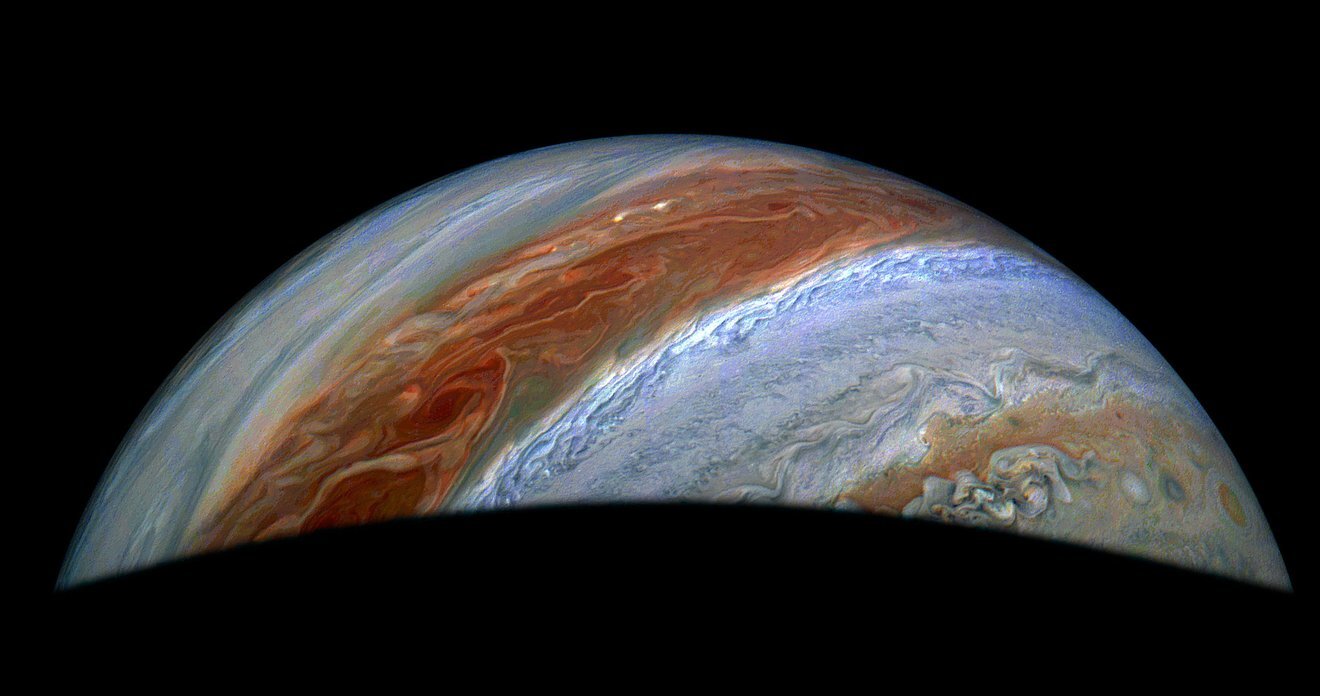
JunoCam, the visible light imager aboard NASA’s Juno, captured this enhanced-color view of Jupiter’s northern high latitudes from an altitude of about 36,000 miles (58,000 kilometers) above the giant planet’s cloud tops during the spacecraft’s 69th flyby on Jan. 28, 2025.
Credit: Image data: NASA/JPL-Caltech/SwRI/MSSS Image processing: Jackie Branc (CC BY)
New data from the agency’s Jovian orbiter sheds light on the fierce winds and cyclones of the gas giant’s northern reaches and volcanic action on its fiery moon.
NASA’s Juno mission has gathered new findings after peering below Jupiter’s cloud-covered atmosphere and the surface of its fiery moon, Io. Not only has the data helped develop a new model to better understand the fast-moving jet stream that encircles Jupiter’s cyclone-festooned north pole, it’s also revealed for the first time the subsurface temperature profile of Io, providing insights into the moon’s inner structure and volcanic activity.
Team members presented the findings during a news briefing in Vienna on Tuesday, April 29, at the European Geosciences Union General Assembly.
“Everything about Jupiter is extreme. The planet is home to gigantic polar cyclones bigger than Australia, fierce jet streams, the most volcanic body in our solar system, the most powerful aurora, and the harshest radiation belts,” said Scott Bolton, principal investigator of Juno at the Southwest Research Institute in San Antonio. “As Juno’s orbit takes us to new regions of Jupiter’s complex system, we’re getting a closer look at the immensity of energy this gas giant wields.”
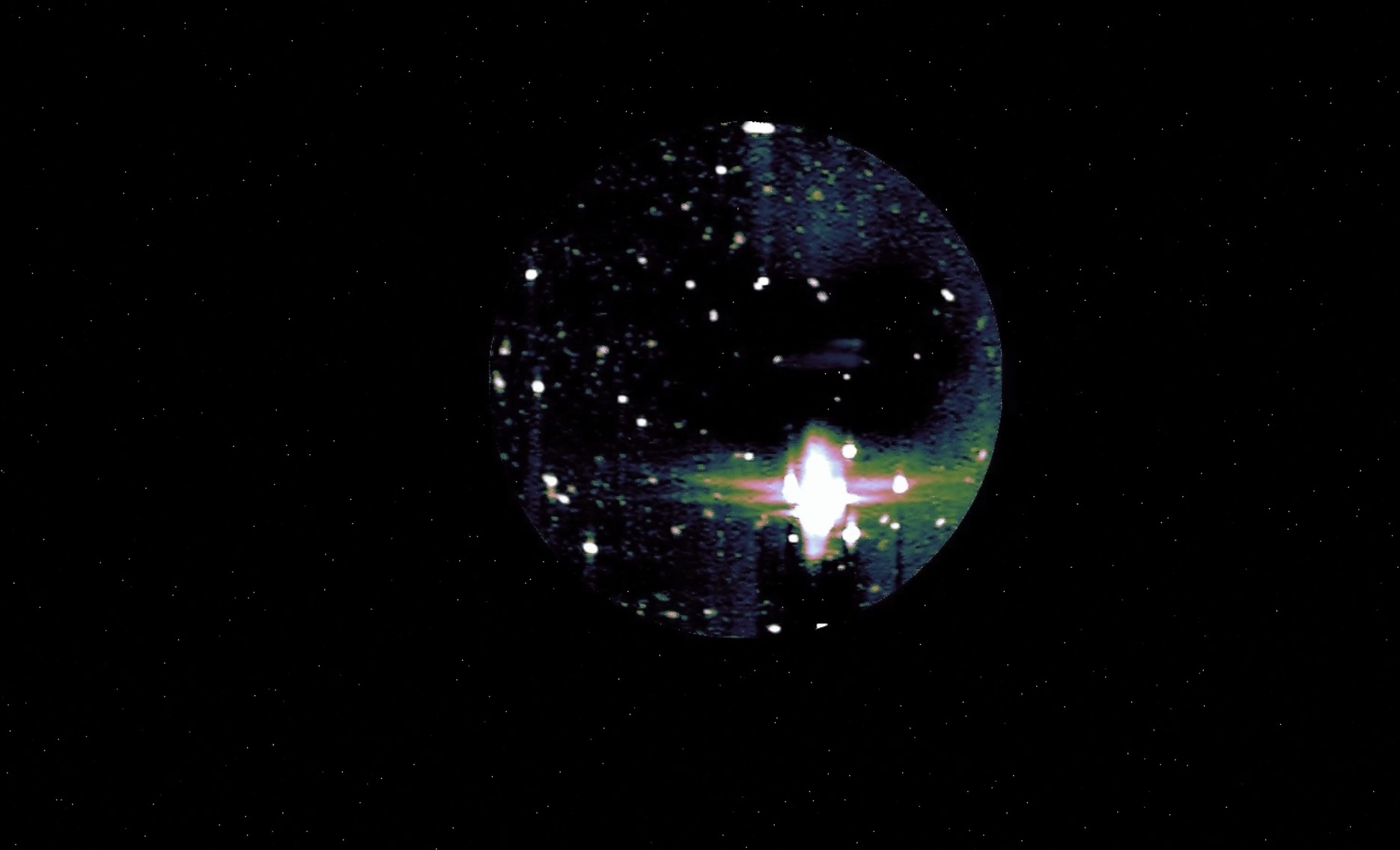
Made with data from the JIRAM instrument aboard NASA’s Juno, this animation shows the south polar region of Jupiter’s moon Io during a Dec. 27, 2024, flyby. The bright spots are locations with higher temperatures caused by volcanic activity; the gray areas resulted when Io left the field of view.
Credit: NASA/JPL/SwRI/ASI - JIRAM Team (A.M.)
Lunar Radiator
While Juno’s microwave radiometer (MWR) was designed to peer beneath Jupiter’s cloud tops, the team has also trained the instrument on Io, combining its data with Jovian Infrared Auroral Mapper (JIRAM) data for deeper insights.
“The Juno science team loves to combine very different datasets from very different instruments and see what we can learn,” said Shannon Brown, a Juno scientist at NASA’s Jet Propulsion Laboratory in Southern California. “When we incorporated the MWR data with JIRAM’s infrared imagery, we were surprised by what we saw: evidence of still-warm magma that hasn’t yet solidified below Io’s cooled crust. At every latitude and longitude, there were cooling lava flows.”
The data suggests that about 10% of the moon’s surface has these remnants of slowly cooling lava just below the surface. The result may help provide insight into how the moon renews its surface so quickly as well as how as well as how heat moves from its deep interior to the surface.
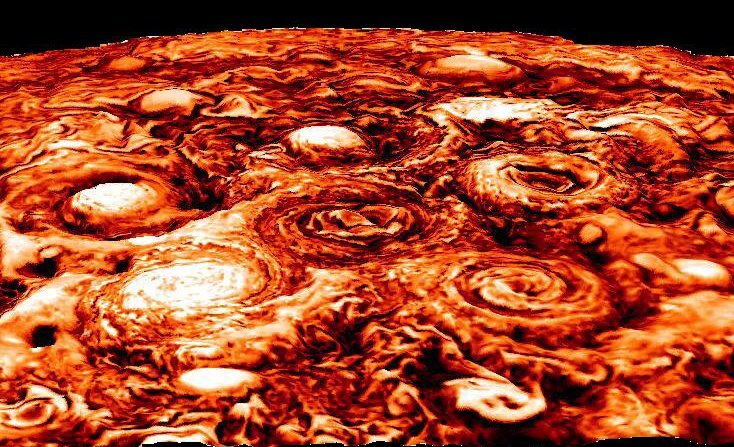
This composite image, derived from data collected in 2017 by the JIRAM instrument aboard NASA’s Juno, shows the central cyclone at Jupiter’s north pole and the eight cyclones that encircle it. Data from the mission indicates these storms are enduring features.
Credit: NASA/JPL-Caltech/SwRI/ASI/INAF/JIRAM
“Io’s volcanos, lava fields, and subterranean lava flows act like a car radiator,” said Brown, “efficiently moving heat from the interior to the surface, cooling itself down in the vacuum of space.”
Looking at JIRAM data alone, the team also determined that the most energetic eruption in Io’s history (first identified by the infrared imager during Juno’s Dec. 27, 2024, Io flyby) was still spewing lava and ash as recently as March 2. Juno mission scientists believe it remains active today and expect more observations on May 6, when the solar-powered spacecraft flies by the fiery moon at a distance of about 55,300 miles (89,000 kilometers).
Colder Climes
On its 53rd orbit (Feb 18, 2023), Juno began radio occultation experiments to explore the gas giant’s atmospheric temperature structure. With this technique, a radio signal is transmitted from Earth to Juno and back, passing through Jupiter’s atmosphere on both legs of the journey. As the planet’s atmospheric layers bend the radio waves, scientists can precisely measure the effects of this refraction to derive detailed information about the temperature and density of the atmosphere.
So far, Juno has completed 26 radio occultation soundings. Among the most compelling discoveries: the first-ever temperature measurement of Jupiter’s north polar stratospheric cap reveals the region is about 11 degrees Celsius cooler than its surroundings and is encircled by winds exceeding 100 mph (161 kph).
Polar Cyclones
The team’s recent findings also focus on the cyclones that haunt Jupiter’s north. Years of data from the JunoCam visible light imager and JIRAM have allowed Juno scientists to observe the long-term movement of Jupiter’s massive northern polar cyclone and the eight cyclones that encircle it. Unlike hurricanes on Earth, which typically occur in isolation and at lower latitudes, Jupiter’s are confined to the polar region.
By tracking the cyclones’ movements across multiple orbits, the scientists observed that each storm gradually drifts toward the pole due to a process called “beta drift” (the interaction between the Coriolis force and the cyclone’s circular wind pattern). This is similar to how hurricanes on our planet migrate, but Earthly cyclones break up before reaching the pole due to the lack of warm, moist air needed to fuel them, as well as the weakening of the Coriolis force near the poles. What’s more, Jupiter’s cyclones cluster together while approaching the pole, and their motion slows as they begin interacting with neighboring cyclones.
“These competing forces result in the cyclones ‘bouncing’ off one another in a manner reminiscent of springs in a mechanical system,” said Yohai Kaspi, a Juno co-investigator from the Weizmann Institute of Science in Israel. “This interaction not only stabilizes the entire configuration, but also causes the cyclones to oscillate around their central positions, as they slowly drift westward, clockwise, around the pole.”
The new atmospheric model helps explain the motion of cyclones not only on Jupiter, but potentially on other planets, including Earth.
“One of the great things about Juno is its orbit is ever-changing, which means we get a new vantage point each time as we perform a science flyby,” said Bolton. “In the extended mission, that means we’re continuing to go where no spacecraft has gone before, including spending more time in the strongest planetary radiation belts in the solar system. It’s a little scary, but we’ve built Juno like a tank and are learning more about this intense environment each time we go through it.”
Quelle: NASA
----
Update: 23.07.2025
.
NASA Shares How to Save Camera 370-Million-Miles Away Near Jupiter
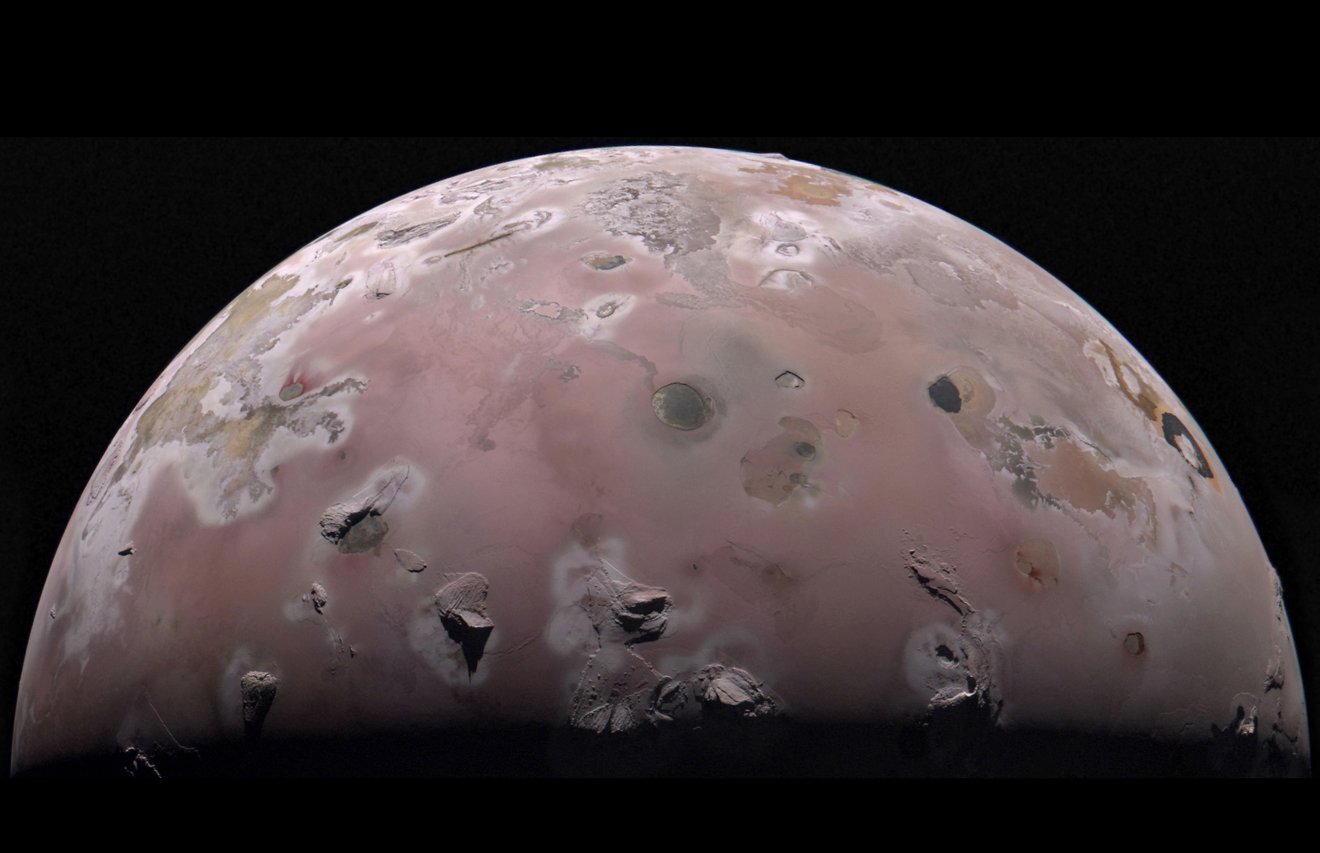
The north polar region of Jupiter’s volcanic moon Io was captured by the JunoCam imager aboard NASA’s Juno during the spacecraft’s 57th close pass of the gas giant on Dec. 30, 2023. A technique called annealing was used to help repair radiation damage to the camera in time to capture this image. Credit: Image data: NASA/JPL-Caltech/SwRI/MSSS. Image processing by Gerald Eichstädt
An experimental technique rescued a camera aboard the agency’s Juno spacecraft, offering lessons that will benefit other space systems that experience high radiation.
The mission team of NASA’s Jupiter-orbiting Juno spacecraft executed a deep-space move in December 2023 to repair its JunoCam imager to capture photos of the Jovian moon Io. Results from the long-distance save were presented during a technical session on July 16 at the Institute of Electrical and Electronics Engineers Nuclear & Space Radiation Effects Conference in Nashville.
JunoCam is a color, visible-light camera. The optical unit for the camera is located outside a titanium-walled radiation vault, which protects sensitive electronic components for many of Juno’s engineering and science instruments.
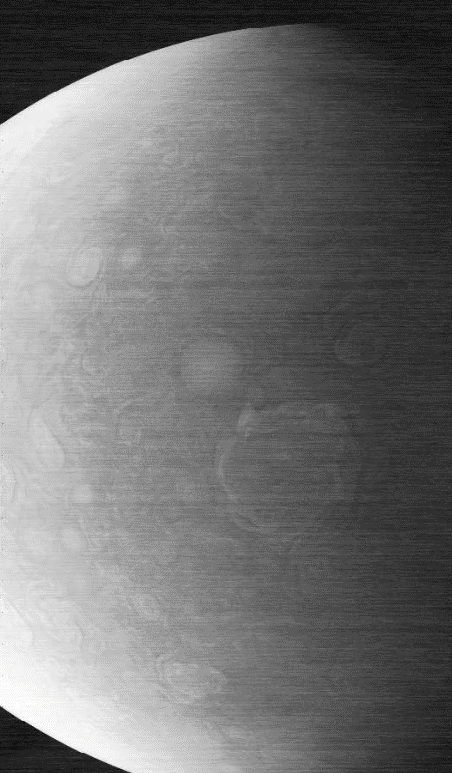
The graininess and horizontal lines seen in this JunoCam image show evidence that the camera aboard NASA’s Juno mission suffered radiation damage. The image, which captures one of the circumpolar cyclones on Jupiter’s north pole, was taken Nov. 22, 2023.
This is a challenging location because Juno’s travels carry it through the most intense planetary radiation fields in the solar system. While mission designers were confident JunoCam could operate through the first eight orbits of Jupiter, no one knew how long the instrument would last after that.
Throughout Juno’s first 34 orbits (its prime mission), JunoCam operated normally, returning images the team routinely incorporated into the mission’s science papers. Then, during its 47th orbit, the imager began showing hints of radiation damage. By orbit 56, nearly all the images were corrupted.
Long Distance Microscopic Repair
While the team knew the issue may be tied to radiation, pinpointing what, specifically, was damaged within JunoCam was difficult from hundreds of millions of miles away. Clues pointed to a damaged voltage regulator that is vital to JunoCam’s power supply. With few options for recovery, the team turned to a process called annealing, where a material is heated for a specified period before slowly cooling. Although the process is not well understood, the idea is that the heating can reduce defects in the material.
“We knew annealing can sometimes alter a material like silicon at a microscopic level but didn’t know if this would fix the damage,” said JunoCam imaging engineer Jacob Schaffner of Malin Space Science Systems in San Diego, which designed and developed JunoCam and is part of the team that operates it. “We commanded JunoCam’s one heater to raise the camera’s temperature to 77 degrees Fahrenheit — much warmer than typical for JunoCam — and waited with bated breath to see the results.”
Soon after the annealing process finished, JunoCam began cranking out crisp images for the next several orbits. But Juno was flying deeper and deeper into the heart of Jupiter’s radiation fields with each pass. By orbit 55, the imagery had again begun showing problems.
“After orbit 55, our images were full of streaks and noise,” said JunoCam instrument lead Michael Ravine of Malin Space Science Systems. “We tried different schemes for processing the images to improve the quality, but nothing worked. With the close encounter of Io bearing down on us in a few weeks, it was Hail Mary time: The only thing left we hadn’t tried was to crank JunoCam’s heater all the way up and see if more extreme annealing would save us.”
Test images sent back to Earth during the annealing showed little improvement the first week. Then, with the close approach of Io only days away, the images began to improve dramatically. By the time Juno came within 930 miles (1,500 kilometers) of the volcanic moon’s surface on Dec. 30, 2023, the images were almost as good as the day the camera launched, capturing detailed views of Io’s north polar region that revealed mountain blocks covered in sulfur dioxide frosts rising sharply from the plains and previously uncharted volcanos with extensive flow fields of lava.
Testing Limits
To date, the solar-powered spacecraft has orbited Jupiter 74 times. Recently, the image noise returned during Juno’s 74th orbit.
Since first experimenting with JunoCam, the Juno team has applied derivations of this annealing technique on several Juno instruments and engineering subsystems.
“Juno is teaching us how to create and maintain spacecraft tolerant to radiation, providing insights that will benefit satellites in orbit around Earth,” said Scott Bolton, Juno’s principal investigator from the Southwest Research Institute in San Antonio. “I expect the lessons learned from Juno will be applicable to both defense and commercial satellites as well as other NASA missions.”
More About Juno
NASA’s Jet Propulsion Laboratory, a division of Caltech in Pasadena, California, manages the Juno mission for the principal investigator, Scott Bolton, of the Southwest Research Institute in San Antonio. Juno is part of NASA’s New Frontiers Program, which is managed at NASA’s Marshall Space Flight Center in Huntsville, Alabama, for the agency’s Science Mission Directorate in Washington. The Italian Space Agency, Agenzia Spaziale Italiana, funded the Jovian InfraRed Auroral Mapper. Lockheed Martin Space in Denver built and operates the spacecraft. Various other institutions around the U.S. provided several of the other scientific instruments on Juno.
Quelle: NASA
----
Update: 27.07.2025
.
JunoCam revived by onboard heat treatment just in time for Io flyby
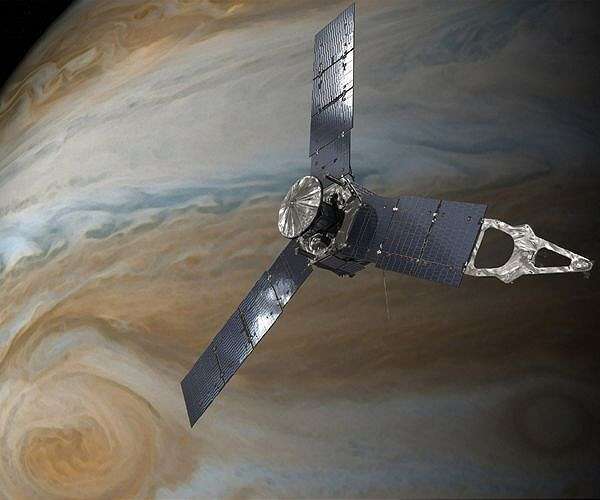
NASA's Juno spacecraft, currently orbiting Jupiter, narrowly salvaged its onboard JunoCam imager through a remote thermal repair maneuver executed in December 2023. The move, initiated from over 370 million miles away, enabled the camera to capture unprecedented views of Io during a close approach. The repair effort was detailed by mission engineers on July 16 at the IEEE Nuclear and Space Radiation Effects Conference in Nashville.
JunoCam, a visible-light color camera designed primarily for public engagement, has also contributed key scientific data throughout Juno's mission. Positioned outside the spacecraft's radiation-shielded vault, the camera is highly exposed to Jupiter's intense radiation belts-considered the most extreme of any planetary environment in the solar system.
Although engineers anticipated JunoCam might endure through eight orbits, it continued to perform reliably for 34 orbits during the prime mission. Trouble emerged by the 47th orbit, and by orbit 56, nearly all images were compromised due to suspected radiation damage.
The mission team hypothesized that the camera's voltage regulator had sustained damage. With no physical repair possible, engineers turned to an annealing technique: heating the camera to 77oF (25oC) using its internal heater in hopes of mitigating silicon defects at the microscopic level.
"We commanded JunoCam's one heater to raise the camera's temperature to 77 degrees Fahrenheit (25 degrees Celsius) - much warmer than typical for JunoCam - and waited with bated breath to see the results," said Jacob Schaffner of Malin Space Science Systems, the firm that developed and operates JunoCam.
The initial round of annealing worked, producing sharp images for several orbits. However, by orbit 55, the degradation resumed. With a key flyby of Io fast approaching, the team gambled on more extreme annealing.
"After orbit 55, our images were full of streaks and noise," said Michael Ravine, JunoCam instrument lead at Malin. "We tried different schemes for processing the images to improve the quality, but nothing worked. With the close encounter of Io bearing down on us in a few weeks, it was Hail Mary time: The only thing left we hadn't tried was to crank JunoCam's heater all the way up and see if more extreme annealing would save us."
Initially, the intensified heating showed little improvement. But as Juno neared Io in late December, the imagery began improving rapidly. On Dec. 30, 2023, during a pass just 930 miles from the volcanic moon, JunoCam captured near-original-quality images. The photos revealed rugged blocks blanketed in sulfur dioxide frost and previously unseen volcanic formations with extensive lava flows.
Juno has now completed 74 orbits around Jupiter. Although image noise returned during the latest orbit, the team continues refining the annealing approach, aiming to extend JunoCam's useful life. Variants of the thermal repair method are now being tested on other Juno instruments and systems.
"Juno is teaching us how to create and maintain spacecraft tolerant to radiation, providing key insights that will benefit not only Juno, but satellites in orbit around Earth," said Scott Bolton, Juno's principal investigator at the Southwest Research Institute. "I expect the lessons learned from Juno will be applicable to both defense and commercial satellites as well as other NASA missions."
NASA's Jet Propulsion Laboratory manages the Juno mission, part of the agency's New Frontiers Program, with contributions from the Italian Space Agency and other partners. The spacecraft was built and is operated by Lockheed Martin Space.
Quelle: SD
----
Update: 4.09.2025
.
Juno Detected the Final Missing Auroral Signature from Jupiter’s Four Largest Moons
Jupiter hosts the brightest and most spectacular auroras in the Solar System. Near its poles, these shimmering lights offer a glimpse into how the planet interacts with the solar wind and moons swept by Jupiter’s magnetic field. Unlike Earth’s northern lights, the largest moons of Jupiter create their own auroral signatures in the planet’s atmosphere — a phenomenon that Earth’s Moon does not produce. These moon-induced auroras, known as “satellite footprints,” reveal how each moon interacts with its local space environment.
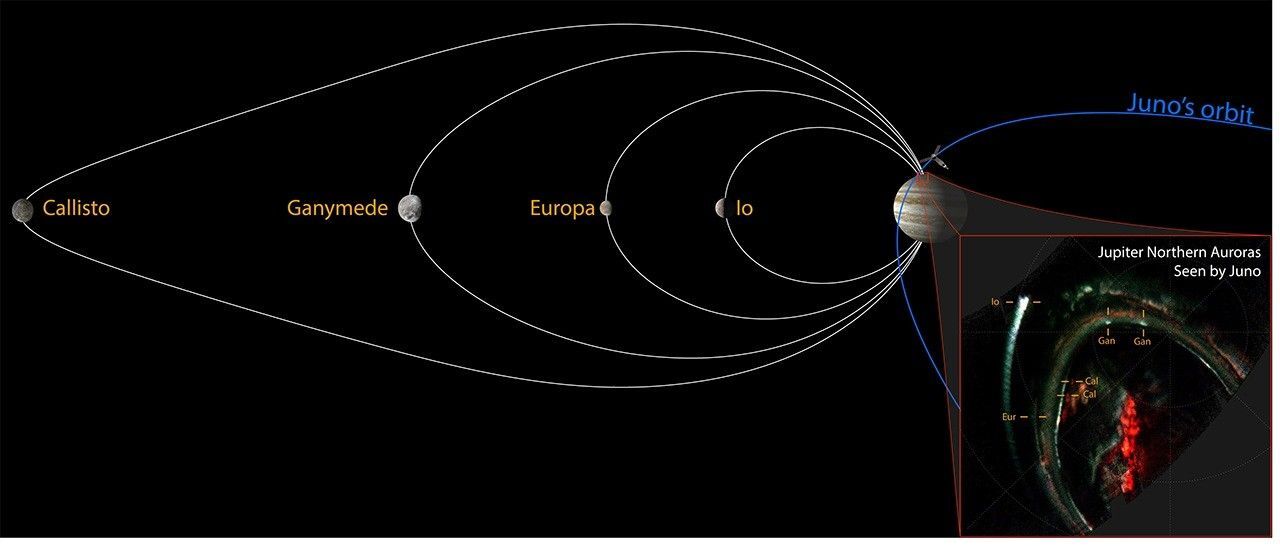
Before NASA’s Juno mission, three of Jupiter’s four largest moons, known as Galilean moons — Io, Europa, and Ganymede — were shown to produce these distinct auroral signatures. But Callisto, the most distant of the Galilean moons, remained a mystery. Despite multiple attempts using NASA’s Hubble Space Telescope, Callisto’s footprint had proven elusive, both because it is faint and because it most often lies atop the brighter main auroral oval, the region where auroras are displayed.
NASA’s Juno mission, orbiting Jupiter since 2016, offers unprecedented close-up views of these polar light shows. But to image Callisto’s footprint, the main auroral oval needs to move aside while the polar region is being imaged. And to bring to bear Juno’s arsenal of instruments studying fields and particles, the spacecraft's trajectory must carry it across the magnetic field line linking Callisto and Jupiter.
These two events serendipitously occurred during Juno’s 22nd orbit of the giant planet, in September 2019, revealing Callisto’s auroral footprint and providing a sample of the particle population, electromagnetic waves, and magnetic fields associated with the interaction.
Jupiter’s magnetic field extends far beyond its major moons, carving out a vast region (magnetosphere) enveloped by, and buffeted by, the solar wind streaming from our Sun. Just as solar storms on Earth push the northern lights to more southern latitudes, Jupiter’s auroras are also affected by our Sun’s activity. In September 2019, a massive, high-density solar stream buffeted Jupiter’s magnetosphere, briefly revealing — as the auroral oval moved toward Jupiter’s equator — a faint but distinct signature associated with Callisto. This discovery finally confirms that all four Galilean moons leave their mark on Jupiter’s atmosphere, and that Callisto’s footprints are sustained much like those of its siblings, completing the family portrait of the Galilean moon auroral signatures.
An international team of scientists led by Jonas Rabia of the Institut de Recherche en Astrophysique et Planétologie (IRAP), CNRS, CNES, in Toulouse, France, published their paper on the discovery, “In situ and remote observations of the ultraviolet footprint of the moon Callisto by the Juno spacecraft,” in the journal Nature Communications on Sept. 1, 2025.
Quelle: NASA
